
Sacred Texts Sub Rosa Index Previous Next
Buy this Book at Amazon.com

A QUESTION may here arise whether two corresponding pillars, or columns, in the White Tower, London, do not very ingeniously conceal, masonically, the mythic formula of the Mosaic Genesis, 'Male and Female created He them', etc. Refer below to figs. 119, 120.
1. Tor, or 'Hammer of Thor' T(au).

Click to enlarge
Figs. 119-124
|
Figs. 119, 120: Columns to Chapel in the 'White Tower', London. Style, Early Norman, 1081. Fig. 119--(1) Mystic 'Tau'; (2) Male, Right; (3) Female, Left. Fig. 122: Egypt, Persia: Sect of Ali; Fig. 123: Castle-Rising Church, Norfolk. Fig. 124: Romsey Abbey, Hants. |

Click to enlarge
Figs. 125-127
|
Fig. 125: St. Peter's Church, Northampton; Fig. 126: S--out of the Arms of the +. (Font, Runic and Saxon, Bridekirk Church, Cumberland); Fig. 127: ת ω T: The Ten Commandments, 'Tables of Stone' Five 'Commandments' to the Right, Masculine, 'Law', Five 'Commandments' to the Left, the 'Prophets', or the 'Gospel' |
2. Corinthian Volutes, or 'Ram's Horns'.
The crescent moon and star is a Plantagenet badge. It is also the Badge of the Sultan of Turkey. Also, with a difference, it displays the insignia of Egypt.
The flag of Egypt is the ensign of the sect of Ali (the second Mohammedan head of religion), which is 'Mars, a Crescent, Luna; within the horns of which is displayed an estoile of the second'--abandoning the vert, or green, of the 'Hadgi', or of Mecca, the site of the apotheosis of Mohammed. The Mohammedan believers of the sect of Ali rely on the 'masculine principle'--more closely, in this respect, assimilating with the Jews; and therefore their distinctive heraldic and theological colour is red, which is male, to the exclusion of the other Mohammedan colour,
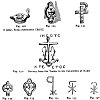
Click to enlarge
Figs. 128-136
|
Fig. 130 A lamp, Roma Sotteranea ΙΧΘΥΣ.'; Fig. 131: Devices from the Tombs in the Catacombs at Rome |
green, which is female. The 'Hadgi', or Pilgrims to Mecca, wear green; the Turkish Mussulmans wear red and green, according to their various. titles of honour, and to their various ranks.
The Hospital of St. Cross, near Winchester, abounds in the earliest Norman mouldings. The architecture of St. Cross presents numerous hermetic suggestions.
The identity of Heathen and of Christian Symbols is displayed in all our old churches in degrees more or less conclusive.
The 'Ten fingers' of the two hands (made up of each 'Table' of Five) are called in old parlance, the ten commandments'. 'I will write the ten commandments

Click to enlarge
Figs. 137-140
|
Fig. 137: Monogram of the Three Figs. 138, 139: The Heathen Monogram Emblems carried in the Mysteries of the Triune; Fig. 140: Monogram of the Saviour. |
in thy face' was spoken in fury, in the old-fashioned days, of an intended assault. The hands explain the meaning of this proverbial expression, interpreted astrologically. Palmistry is called Chiromancy, because Apollo, mythologically, was taught 'letters' by Chiron, the 'Centaur'.
The devices on most Roman Bronze Lamps present continual Gnostic ideas.
The Temple Church, London, will be found to abound with Rosicrucian hieroglyphs and anagrammatical hints in all parts, if reference be made to it by an attentive inquirer--one accustomed to these abstruse studies.
These designs supply a variety of Early Christian Symbols or Hieroglyphs, drawn from Roman originals in all parts of the world.
The Æolian Harp, or Magic Harp, gave forth real strains in the wind. .These were supposed to be communications from the invisible spirits that people the, air in greater or lesser number. See figs. 141, 142.
The above music consists of a magical incantation to the air, or musical Charms, supposed magically to
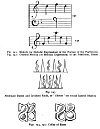
Click to enlarge
Figs. 141-145
|
Fig. 141: Melody (or Melodic Expression) of the Portico of the Parthenon |
be played from the frontispieces, as musical instruments, of two of the most celebrated ancient religious structures. The Cabalists imagined that the arrangements of the stars in the, sky, and particularly the accidental circumvolvent varying speed of the planets of the solar system, produced music--as men know music. The Sophists maintained that architecture, in another sense, was harmonious communication,
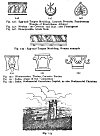
Click to enlarge
Figs. 146-153
|
Fig. 146: Egg-and-Tongue Moulding, Caryatic Prostyle, Pandroseum |
addressed to a capable apprehension--when the architecture was true to itself, and therefore of divine origin. Hence the music on p. 258. These passages were supposed to be magic charms, or invocations, addressed by day and night, to the intelligent beings who filled the air invisibly. They were played from the fronts
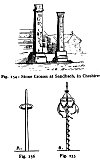
Click to enlarge
Figs. 154-156
Fig. 154: Stone Crosses at Sandbach, in Cheshire
of the Parthenon, Athens, and the Pantheon, Rome, according to the ideas of the superstitious Greeks and of the Oriental Christian Church.
In fig. 153 we have a representation of Bersted Church, as seen (magnified) from a rising hill, over a hop-garden, at about the distance of half a mile. Bersted is a little village, about three miles from Maidstone, Kent, on the Ashford road. In the chancel of Bersted Church, Robert Fludd, or Flood ('Robertus de Fluctibus'), the head of the Rosicrucians in England, lies buried. He died in 1637.
Fig. 155 displays the standard Maypole, or authentic Maypole, with all its curious additions; and we add their explanation. In the upper portion we have the
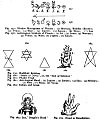
Click to enlarge
Figs. 157-165
|
Fig. 157: Hindoo Monograms of Planets: (1) Mercury, Buddha (Boodh)' (2) Venus; (3) Mars; (4) Jupiter; (5) Saturn; (6) Moon; (7) Sun |
[paragraph continues] Apex of the Phallus, the Quatre-feuilles, and the Discus or Round. The lower portion is the Linga, Lingham, or Phallus, 'wreathed'; also the 'Pole' of the ship 'Argo' ('Arco'); otherwise the 'Tree of Knowledge'. The ribbons of the Maypole should be of the seven prismatic colours.
Fig. 156 shows the union of the Phallus and Yoni, and exhibits Unmistakably the destination and purpose of the familiar Maypole.

Click to enlarge
Figs. 166, 167
|
Fig. 166: Egyptian Alto-Relievo (British Museum); Fig. 167, 'Hook of Saturn', 'Crook of Bishops'. |
Each finger in fig. 162 is devoted to a separate planet. Refer to the engraving of the hand.
Fig. 167, 'Hook of Saturn', 'Crook of Bishops'. 'By hook or crook', meaning, 'By fair means or foul', is a proverbial expression, continually heard.
There are two works which will assist in throwing light upon that mystic system of the ancients, probably originating in the dreaming East, that refers the production of music to architectural forms or geometric diagrams; as columns and entablatures, or upright lines and cross-lines, and mathematical arcs and diagonals, in their modifications and properties, of course are. These books, which will help to explain the passages of music given at p. 258, figs. 141, 142, are Hay's Natural Principles and Analogy of the Harmony of Form, and a very original and learned musical production, entitled The Analogy of the Laws of Musical Temperament to the Natural Dissonance of Creation, by M. Vernon, published in London in 1867. Through a strange theory, the music at p. 258 of our book is taken as the expression of the geometrical fronts of the two great temples, the Parthenon at Athens and the Pantheon at Rome, which are supposed to have been built with perfect art. We have 'translated' these phantom Æolian melodies played in the winds (so to express it), and fixed them in modern musical notation.